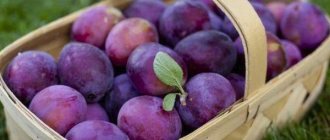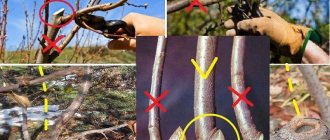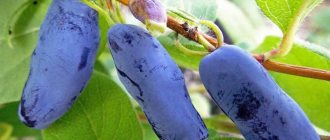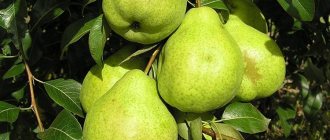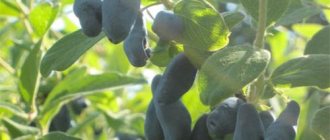general description
The yellow honey plum was bred by Ukrainian breeders in the 50s. last century by crossing the large-fruited American Jefferson plum and the Western European Peach plum. From the first, the hybrid received the ability for frost and drought resistance, immunity from diseases and pests, and tall stature; from the second, abundant fertility and early ripeness. Among the people, the plum received a second name, honey white, although it would be more correct to call it Renklod early.
Initially, the variety was grown in the steppe regions of Ukraine, and then migrated to the middle Russian latitudes, where it perfectly demonstrated its ability to endure in unfavorable climatic conditions. The trees are distinguished by their considerable height, reaching 5-7 m in adulthood. The crown is characterized by slight density, and few skeletal branches are formed. The shape is round, spreading. The latter fact must be taken into account when dividing the territory for an orchard. The remaining fruit crops should be located at least 3-5 m from the plum tree.
Advantages and disadvantages
Honey plum does not lose popularity due to its benefits. The advantages of culture include:
- endurance and resistance to adverse conditions and diseases;
- unpretentiousness to the soil and low maintenance requirements;
- abundant fruiting;
- tasty and large plums;
- a non-thickened crown that does not need to be constantly trimmed;
- adaptation to different conditions, the ability to grow in different climatic conditions;
- attractive appearance;
- transportability.
Among the disadvantages are:
- weak immunity against fungal diseases;
- poor shade tolerance;
- self-sterility and the obligatory presence of pollinators;
- takes up a lot of space on the site.
Fruit
The fruits are oval or pear-shaped. Slightly flattened and out of proportion at the edges. The average weight of a ripe plum is 40-50 g. The ventral seam is almost invisible, making the fruit appear whole. Upon reaching maturity, the dense skin becomes transparent, acquiring a greenish-yellow hue. After being picked from the tree, the fruits finally turn yellow, and where sunlight fell on them, a characteristic light orange blush or pinkish spots appear. The outer surface of the plum is covered with a whitish waxy coating of moderate thickness.
Related article:
Fertilize the plum correctly
The pulp is juicy, has a dense structure, and is separated from the stone with some effort. The color is the same deep yellow as the outer skin. Sometimes fibers with a greenish tint may be found. Already from the name it is clear that the taste of plum is sweet, with a honey aftertaste, but not cloying. There is a slight sourness, making the tasting especially pleasant. Transportability is good, storage conditions are standard, as for other garden fruits.
Honey plum has an early ripening period. By the beginning of August it can be picked from trees and eaten. Seedlings begin to bear fruit 3-4 years after planting, which is also considered a fairly early indicator. Under optimal weather conditions, the yield per tree is 35-40 kg. The culture is resistant to frost and spring frosts, and is not afraid of drought, pests and diseases.
Most often, plums are consumed fresh, but they are also suitable for preservation. They make delicious compotes, preserves, confitures, jams, etc. Plum filling is used to make pies, cookies, pies and other baked goods.
Plum "Honey" 1 seedling
Plum "Honey" 1 seedling
- Guaranteed delivery on time
- Absolute compliance with the description
- Only well-known varieties
- Decent packaging with proper labeling
- Each plant is checked by specialists
- Variety of choices from classic to exotic
Plum "Honey" is an early ripening variety of domestic plum with high frost resistance. The crop is grown in the Moscow region and in central Russia; the plant is characterized by excellent taste of the fruit, high yield, and drought resistance.
Description and characteristics of the variety
The tree is distinguished by its high growth vigor; after planting in the garden, it quickly grows up to 7 meters and forms a wide crown of medium density.
Fruiting is annual and occurs 3 years after planting in a permanent place. Fruit buds form on last year's shoots. The variety is self-sterile; to obtain fruit, pollinators are planted:
- Early Hungarian Donetsk;
- Renklod Karbysheva.
The yield of an adult tree reaches 35 kg, while the number of ovaries is affected by weather conditions: wind, heavy rains.
The inflorescences bloom in early May, the fruits ripen in mid-July, they are characterized by:
- oval shape;
- weighing up to 50 g;
- thick skin;
- yellow color with pink blush;
- transparent and juicy pulp, very aromatic;
- sweet taste with notes of honey.
Thanks to the dense skin, the fruits tolerate transportation well. In a dry place, they protect their appearance and taste for 2 months. The fruits are universally used, suitable for fresh use and for homemade preparations.
Features of cultivation and care
Honey plum seedlings are planted in spring or autumn in a sunny area, protected from the north wind with deep groundwater. Best soils:
- sandy;
- sandy loam;
- loamy.
The variety is drought-resistant, but to obtain a good harvest, watering twice a month is required. To prevent diseases and pests:
- apply preventive treatment;
- add fertilizing;
- perform sanitary pruning.
How to make a purchase
Our store offers you to buy “Honey” plum seedlings at a competitive price. The website contains a description, photos of the culture, and customer reviews.
Delivery to Moscow, Krasnodar, St. Petersburg, Samara, Rostov, Stavropol, Nizhny Novgorod, Voronezh, Volgograd and other cities and regional centers of Russia is carried out by a transport company.
Source of the article: https://vesna-osen.ru/catalog/plants/sliva_medovaya_zheltaya_1_sazhenets/
Pollinators
Yellow plum belongs to the category of self-sterile fruit crops. This means that in the absence of nearby pollinating trees, ovaries will not form on flowers. Accordingly, you can get a full harvest only if you plant other plum trees on the site, and within a radius of no further than 50-60 m. Renklod Karbysheva and Vengerka Donetskaya are considered the best varieties for pollination, although, by and large, any early varieties of plums are suitable. If the area of the site does not allow you to place the required number of garden trees, you can use the technique of grafting the necessary cuttings into the crown.
Related article:
5 varieties of winter-hardy plums for Altai and Western Siberia
Harvesting
Honey plum belongs to different varieties . Plums are harvested from late July to early August.
Healthy! First, remove the plums from the lowest branches, then rise higher and higher. Since the tree is tall, a ladder is used when harvesting. Up to 35 kg of berries are harvested from one plum tree.
Carefully pick off the fruits that you want to store with their stems so as not to affect the waxy coating on the fruits. Place the berries in wooden boxes, having previously covered them with paper. Do 3 layers. Indoors at an air temperature of 0-2°C, humidity 90%, the berries will be stored for 60 days. You can place the berries in the refrigerator, wrapping them in plastic with holes made.
Landing
Since this type of plum has a high degree of tolerance to unfavorable environmental factors, there are no special requirements for its agricultural technology. In the regions of the middle zone, it is recommended to plant seedlings in the spring, since there is a risk of freezing during autumn planting.
The place should be well lit, without drafts, and far from groundwater. The depth of the hole is on average 80 cm, the diameter is approximately the same. It is necessary to fill the bottom with a mixture of humus and soil and leave the hole open for at least a few days. The seedling is placed vertically with its roots spread out on the prepared soil, sprinkled with the remaining soil on top and compacted. Immediately after planting, you need to water the tree with 8-10 liters of water.
Further care
Caring for the White plum must be systematic. In spring, the tree is cleared of old branches and broken shoots. Trimming is carried out to 1/3 of the length. To prevent fungal infection, it is recommended to remove any remaining leaves after winter.
The hybrid does not require fertilizers for the first 2 years after planting. During this period, it consumes useful substances that were added to the hole when the tree was installed. In the third year, seedlings are fed as follows:
- organic and nitrogen fertilizers are applied in early spring;
- When flowers appear, potassium mixtures are added to the soil;
- After the buds fall, phosphorus fertilizers are introduced into the soil.
After each use of these substances, you need to dig up the soil in the hole near the trunk, and then water it with warm water. To protect against diseases, you need to destroy all weeds near the tree. The seedlings are hilled up, the soil is loosened and then mulched with peat (layer thickness 4 cm).
It is recommended to water White plum once a week. To do this you will need 20-40 liters of water for each specimen. The procedure is carried out early in the morning.
Important! The soil should be moistened to a depth of at least 0.4 m.
In extreme heat, it is worth increasing the intensity of watering 2-3 times, but you should not flood the tree trunk ditch. This will lead to the development of diseases and loss of part of the crop.
To protect seedlings from severe frosts, experienced gardeners recommend wrapping White plum trunks with burlap and cellophane. If the cold gets worse, you can fumigate the plantings with smoke and additionally insulate the trees with thick material.
Important! At low temperatures, the branches of the hybrid freeze and then may break off. Because of this, some plants will not be able to recover in the spring.
To destroy emerging garden pests, you need to use drugs like Inta-Vir, which kill not only aphids, flies or butterflies, but also prevent caterpillars from reproducing.
To prevent various diseases, the following measures need to be taken:
- whitewash tree trunks with lime;
- treat their branches with Bordeaux mixture;
- remove all old and broken branches;
- burn last year's leaves.
If these procedures do not help, then the area affected by fungi is cleaned and then treated with special preparations that destroy parasites. It is recommended to fight viral diseases with the help of special store-bought products.
Viral diseases of honey plum
Trimming
Pruning can be done in several ways:
- Sparsely tiered. Standard method of crown formation for tall plum trees. In the first year, the central shoot is left 40-45 cm, and in the next 3-5 years, 2-3 tiers are created, each of which has 5-8 skeletal branches. Then the main trunk is cut off. With this technique, it will not be possible to influence the final height of the tree.
- Cupped. The advantage of this method is that it allows you to achieve maximum access to light and ventilation of the crown. As soon as a tier of 3-4 branches directed in different directions is formed, the central conductor is removed. Further, it is only necessary to maintain the crown in the appropriate shape, preventing it from thickening. The height of trees with cup-shaped pruning does not exceed 3-3.5 m.
Related article:
6 best varieties of blue plums that are easy to grow and will delight you with an excellent harvest
In addition to formative pruning, sanitary and maintenance pruning should also be carried out regularly to promote better yields and prevent pests.
Read about the schemes for proper plum pruning in the article.
Fertilizer
Since humus is added to the hole in preparation for planting, additional fertilizers are not required in the first year of the plum tree. Fertilizing should begin when the tree reaches two years of age. Provided that a one-year-old seedling was initially planted. Organic matter should be added in the spring, when it is necessary to stimulate plant growth. Plum responds well to nitrogen-containing fertilizers.
In anticipation of flowering, the following preventive measures are carried out on the tree: carefully loosen the soil around the perimeter of the tree trunk, and also apply fertilizers in the form of urea and potassium sulfate. During the fruiting period, it will not be superfluous to nourish the soil with nitrophoska and urea. Honey plum very gratefully accepts potassium-containing fertilizers, so during the season it can be sprayed with potassium humate 2-3 times.
Growing a tree
Properly carried out planting work increases the chances of obtaining high yields.
Selection and time of landing site
It is optimal to plant honey plum in early spring - in March, when warm weather sets in. It is propagated by seedlings. Preparatory activities are carried out in October. In the southern regions, plum trees can be planted in the fall; the main thing is to fertilize the area with humus and lime two weeks before planting day.
Honey plum grows and bears fruit better in well-lit meadows protected from draft winds, where groundwater is low. The soil for planting honey plum can be either clay or sandy. In order for the fruits to be sweet and juicy, and the tree not to get sick, it is necessary to maintain a distance of 3-5 meters between neighboring plantings and this variety.
It is effective to place the Honey plum near the elderberry, which protects it from small aphids; also neighbors can be: cherry, sweet cherry, peach, apricot and apple tree. But currant bushes, pear, birch, walnut and coniferous trees do not get along with the Honey plum.
Seedling preparation
It is recommended to purchase honey plums from nurseries or specialized retail outlets. When choosing seedlings, you should pay attention to the root system; it should be well developed, without traces of mold or disease.
The trunk should not contain any damage; there should be live fruit buds on the branches. The height of a young Honey plum should be no more than 1.5 meters.
If you plant tall seedlings, the process of adaptation and rooting will occur slowly and painfully for the plant. When purchasing a plum with a closed root system, planting is done together with a lump of earth. Before planting, it is recommended to treat exposed roots with Kornevin’s solution, keeping them in it for 2-3 hours.
Landing technology
The algorithm of actions regarding planting the Honey plum in a permanent place provides:
- Excavation of a pit. The top layer of soil 30 centimeters thick is removed to the side, and the rest is completely removed; it is not suitable for draining. The pit dimensions are 60×60 centimeters.
- Installing a wooden peg in the hole to tie up the Honey plum if its roots are exposed.
- Laying a drainage layer of broken bricks and crushed stone. Moisture should not stagnate in the ground.
- Adding a nutrient composition from fertile soil, cow manure (2 buckets), wood ash (500 grams), superphosphate (100 grams) and potassium chloride (85 grams).
- Place the seedling in the center of the hole. If the underground part is open, then the roots should be spread to the sides.
- Sprinkling honey plum roots. There is no need to deepen the root collar; it should be 5 centimeters higher from the soil level. To avoid voids, the soil is carefully compacted.
- Irrigation using 2 buckets of water.
To preserve moisture in the tree trunk and from weeds, the soil is mulched with peat.
See also
Description of the plum variety Volga Beauty, cultivation and careRead
Pest Control
The honey plum variety is characterized by stable immunity to most existing diseases; however, prevention should not be neglected. In spring and autumn, trees need sanitary pruning and thinning of the green crown. After the autumn leaf fall, be sure to remove all fallen leaves, small twigs and other debris, and also weed the tree trunk circle from weeds. This is done in order to get rid of (or minimize the number of) pests preparing for the winter. The last stage is treating the trees with Bordeaux solution or Hom product based on copper oxychloride.
Related article:
What an experienced gardener needs to know about plum propagation
Reviews
Olga, Yeisk:
“We met this early variety ten years ago, and since then it has been growing constantly in our garden. Since we live in the Krasnodar region, plums begin to ripen at the end of July. The first fruits we collect are gigantic, 65-80 g each, then they become smaller, on average 40-45 g. The taste is really honey, and so is the smell. We eat it fresh, it’s a shame to send such beauty away for conservation. They don’t last long, so we treat everyone who comes to visit.”
Ivan, Korolev:
“There are three plum trees of the Honey variety in the garden, and they have grown very quickly. Renklod Karbysheva was planted as a pollinator, everything worked out. Plum is very tasty, juicy, sweet. Ripens by mid-August. We don’t insulate for the winter, only sanitary pruning and fertilizing.”


